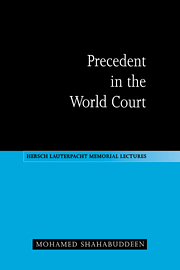Book contents
- Frontmatter
- Contents
- Foreword
- Preface
- List of abbreviations
- 1 Introduction
- 2 The growth of the Court's case law
- 3 Range of precedential resources
- 4 The bases of the system
- 5 The Advisory Committee of Jurists
- 6 The view taken by the League of Nations
- 7 The possibility of judge-made international law
- 8 Stare decisis
- 9 Distinguishing
- 10 Departing from a previous decision
- 11 Ratio decidendi and obiter dictum
- 12 Advisory opinions and decisions of chambers
- 13 The precedential impact of individual opinions
- 14 Effect and scope of the Court's case law
- 15 Conclusion
- Index
4 - The bases of the system
Published online by Cambridge University Press: 04 May 2010
- Frontmatter
- Contents
- Foreword
- Preface
- List of abbreviations
- 1 Introduction
- 2 The growth of the Court's case law
- 3 Range of precedential resources
- 4 The bases of the system
- 5 The Advisory Committee of Jurists
- 6 The view taken by the League of Nations
- 7 The possibility of judge-made international law
- 8 Stare decisis
- 9 Distinguishing
- 10 Departing from a previous decision
- 11 Ratio decidendi and obiter dictum
- 12 Advisory opinions and decisions of chambers
- 13 The precedential impact of individual opinions
- 14 Effect and scope of the Court's case law
- 15 Conclusion
- Index
Summary
Introductory remarks
The Court's position as the principal judicial organ of the United Nations has been mentioned in explanation of its use of precedents. The argument is that, as such an organ, the Court shares in the responsibility of the United Nations to maintain peace, and that, in order to do so, it has an implied power to ensure consistency in decisions, lest inconsistencies should create tension within the international community. That is a good reason for adhering to the practice; it is less clear that it is the juridical basis. The practical position of the Permanent Court of International Justice did not always coincide with the theory that it was separate from the League of Nations. It was referred to by no less an authority than President Loder in his inaugural speech as ‘one of the principal organs of the League’; others have thought likewise. There can be no doubt, however, that it was constitutionally not part of the League. Yet it observed the same practice. What is the basis of the practice?
The general jurisprudential basis
There are two bases on which the Court's use of precedents rests. The Court itself being a creature of the Charter and its Statute, its use of precedents must likewise find its authority in these instruments. But these speak both expressly and impliedly; it is important to bear this in mind when estimating the legal character of the great judicial institution established by them.
- Type
- Chapter
- Information
- Precedent in the World Court , pp. 40 - 47Publisher: Cambridge University PressPrint publication year: 1996



